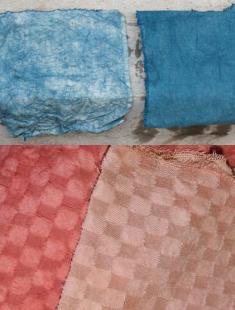Natural dyes, for example walnut (hulls or nuts, but I read nuts produce darker dyes) or cutch (which comes from dried and powdered syrup from steeped Acacia Catechu tree wood), may or may not require scouring (preparation of the fabric by distressing/stripping it of natural waxes that protect the fabric from dying) and mordanting (fixing the color).
Generally, cotton (a cellulose based fabric) requires scouring because cotton is naturally waxy and pectin-y. When scoured, the color goes on as a darker, evener dye; when unscoured, the dye goes on in a scratchy, blotchy way. Unscoured dye jobs will not retain color as much as scoured. Cotton fabric that is already bleached may not need as much scouring.

Unscoured and scoured fabrics
To scour cotton, a container is filled with water and Synthrapol (5ml) and soda ash (aka Sodium Carbonate) (20g) is added for each half pound (250g) of cotton, and its simmered for around an hour.
Mordanting is before dying (or as a part of it) with aluminum acetate. There are other methods which use combinations of aluminum acetate and alum or use titanium oxalate. Mixed into water, 7-10g of aluminum acetate for 100g of cotton. The cotton is soaked in just water for two hours or so, then another pot of water is prepared (hot tap water) and the cotton fabric and the aluminum acetate are both added. Gloves are worn so the cotton can be worked and squeezed.
These descriptions of the process give a rough idea, but each dye has its own recipe(s) for how to achieve a good dye (there are various types of 'good dyes' with various color darknesses and tints).
For example, with cutch a deeper dye can be acheieved by first soaking the cutch powder in caustic soda (weak mixture: 1tsp for 4l of water), soaked for a hour, after which more water is added and the mix is neutralized with acetic acid or vinegar, and this is all added to the dyebath. The fabrics are then put in the dyebath and simmered for a couple hours.
Still talking about cutch, various tints can be acheived. Alum mordant causes a toffee brown dye. Iron at 2-4%wof makes chocolate browns. Soda ash rinse will redden the color. Adding 2%wof hydrogen peroxide during the final 15 minutes of dying will darken the cutch considerably. Leaving the fabric in the dyebath overnight will cause the darkest shades.
Comments: 0